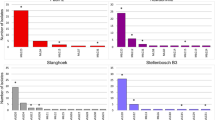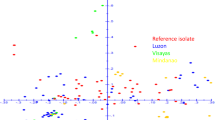Abstract
Setosphaeria turcica is the causal agent of northern corn leaf blight, a foliar maize disease of worldwide economic importance. In Europe, its severity increases. To investigate the pathogen's population-genetic structure in central Europe, a total of 80 isolates was sampled in Germany, Switzerland, France, Austria, and Hungary and investigated with 52 random amplified polymorphic DNA (RAPD) markers. The mating type of the isolates was determined in testcrosses. Among the 73 isolates from maize there were 26 different RAPD haplotypes. All isolates with identical haplotype are considered clonemates. The haplotype shared by most members was represented by 22 isolates from Germany, Switzerland, and France, indicating high fitness and substantial migration. Only a single clone had members in both southeastern Austria and southwestern Switzerland, suggesting that the Alps constitute a major barrier for this pathogen. Several haplotypes differed by only one or two RAPD bands from the predominant haplotype and may have arisen by mutation. Few other clonal lineages were detected. The evolution of some haplotypes could not be explained by mutation alone. Sexual recombination may rarely occur. In population samples from Germany, Switzerland, and France, mating type MAT2 was predominating, while most isolates from Austria and Hungary had MAT1. Seven isolates from Johnson grass (Sorghum halepense), an alternative host of S. turcica, were clonemates and very different in RAPD haplotypes from all isolates collected from maize.
Similar content being viewed by others
References
Abadi R, Perl-Treves R and Levy Y (1996) Molecular variability among Exserohilum turcicumisolates using RAPD (random amplified polymorphic DNA). Can J Plant Pathol 18: 29-34
Borchardt DS, Welz HG and Geiger HH (1998a) Genetic structure of Setosphaeria turcicapopulations in tropical and temperate climates. Phytopathology 88: 322-329
Borchardt DS, Welz HG and Geiger HH (1998b) Spatial and temporal variation of genetic marker patterns in Setosphaeria turcicapopulations from Kenya. J Phytopathology 146: 451-457
Chen D, Zeigler RS, Leung H and Nelson RJ (1995) Population structure of Pyricularia griseaat two screening sites in the Philippines. Phytopathology 85: 1011-1020
Drechsler C (1923) Some graminicolous species of Helminthosporium.I. J Agric Res 24: 641-740
Ducomet V (1903) La brulure du maïs dans le sud-ouest. Jour d'Agr Prat n s 5: 507-511
Fry WE, Goodwin SB, Dyer AT, Matuszak JM, Drenth A, Tooley PW, Sujkowski LS, Koh YJ, Cohen BA, Spielman LJ, Deahl KL, Inglis DA and Sandlan KP (1993) Historical and recent migrations of Phytophthora infestans: Chronology, pathways, and implications. Plant Dis 77: 653-661
Goodwin SB, Cohen BA and Fry WE (1994) Panglobal distribution of a single clonal lineage of the Irish potato famine fungus. Proc Natl Acad Sci USA 91: 11591-11595
Holm S (1979) A simple sequentially rejective multiple test procedure. Scand J Statist 6: 65-70
Kohli Y, Morall RAA, Anderson JB and Kohn LM (1992) Local and trans-Canadian clonal distribution of Sclerotinia sclerotiorumon canola. Phytopathology 82: 875-880
Levy Y and Pataky JK (1992) Epidemiology of northern leaf blight on sweet corn. Phytoparasitica 20: 53-66
Mantel NA (1967) The detection of disease clustering and a generalized regression approach. Cancer Res 27: 209-220
Masias OR and Bergquist RR (1974) Host-specific forms of Trichometasphaeria turcicain relation to homokaryons and heterokaryons in nature. Phytopathology 64: 436-438
Passerini G (1876) La nebbia del granuturco. Bol Comiz Agr Parmense 10
Poole RW(1974) An Introduction to Quantitative Ecology (pp 532). McGraw-Hill, New York
Rohlf FJ (1993) NTSYS-pc, a Numerical Taxonomy and Multivariate Analysis System, version 1.80. Exeter Publ. Co., Setauket, NY
Sneath PHA and Sokal RR (1973) Numerical Taxonomy. W. H. Freeman, San Francisco
Spehar V and Rojć M (1971) Studies on the resistance of maize to Helminthosporium turcicumPass. In: Kovacs I (ed) Proc. 5th Meeting Maize and Sorghum Section of Eucarpia, Budapest
Welz HG, Bassetti P and Geiger HH (1996) Turcicum-Blattdürre und Aleppohirse: zwei Schaderreger auf dem Vormarsch. Mais 24: 66-68
Welz HG and Geiger HH (1995) Globale Variation und Genetik der qualitativen Virulenz von Setosphaeria turcica, dem Erreger des Northern Corn Leaf Blight. Ber. 46. Arbeitstagung Saatzuchtleiter 21-23 Nov. 1995, BAL Gumpenstein pp. 219- 225
Wright S 1942. Isolation by distance. Genetics 28: 114-138
Yap I and Nelson RJ (1996) WinBoot: a program for performing bootstrapping analysis of binary data to determine the confidence limits of UPGMA-based dendrograms. IRRI Discussion Paper series No 14. International Rice Research Institute, Manila, Philippines
Zwatz B (1988) Blattdürre im Mais (Epidemie durch Turcicum-Blattflecken). Pflanzenschutz (Bundesanstalt für Pflanzenschutz, Wien) 4: 3-5
Author information
Authors and Affiliations
Rights and permissions
About this article
Cite this article
Borchardt, D.S., Welz, H.G. & Geiger, H.H. Molecular marker analysis of European Setosphaeria turcica populations. European Journal of Plant Pathology 104, 611–617 (1998). https://doi.org/10.1023/A:1008641920356
Issue Date:
DOI: https://doi.org/10.1023/A:1008641920356




